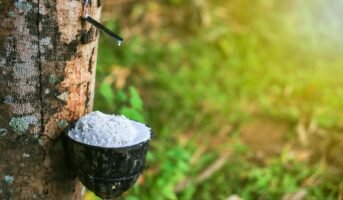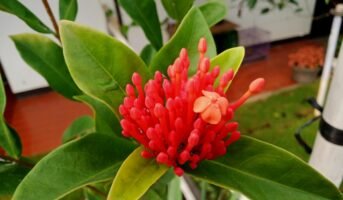Ficus elastica, commonly known as the rubber plant, is a hardy, popular, ornamental plant native to South Asia. Due to its beauty and air purifying qualities, this plant is commonly used in private homes and commercial workplaces.
Those who have got potted rubber plants may like to know how to care for these evergreen tropical plants.
Rubber plant: Facts
| Botanical name: Ficus elastic
Family: Moraceae Plant type: Tree, indoor plant Foliage: Shiny oval leaves Life-cycle: Perennial Height: Outdoors – up to 50 ft, Indoors – up to 3 metres Flowering season: All seasons Flowers: Yellowish-green, extremely rare Toxicity: Sap is toxic; causes mild irritation and burning sensation on direct contact Propagation: Cutting or air layering |
See also: ZZ plant benefits, care and maintenance tips
How to care for a rubber plant?
What type of soil is ideal for Rubber plant?
To propagate a rubber plant, you would require water-draining soil since excess moisture is not good for the plant. One part peat, one part pine bark and one part coarse sand is considered a good mix for a rubber tree.
How much sunlight does a Rubber tree need?
The plant requires at least 6-8 hours of bright indirect sunlight in a day. The leaves would discolour if the plant lacks sunlight. If the plant becomes leggy or sheds leaves that too is a sign of lack of light.
Rubber plant watering tips
Water your rubber plant at least once in 10 days. Allow the soil to dry in between watering. If your plant receives enough sunlight, it would require more water. The leaves would curl inward if there is a lack of water. Over-watering would manifest through droopy leaves and discolouration.
What temperature does a Rubber plant prefer?
Temperature ranging between 65°F to 85°F is ideal for a rubber plant.
Do Rubber trees need humidity?
Being a tropical plant, your Rubber plant would thrive better in a humidity level of 40 to 50%.
What kind of pests attack Rubber plant?
Rubber plants may get scale or mealybugs. Treat these with neem oil and the plant would be good as new.
Rubber plant cleaning
Wipe off the dust from your rubber plant at regular intervals. Use a clean, moist cloth for the purpose.
See also: Spider plant Vastu direction, care and maintenance tips
Key tips
- Fertilise your rubber plant during the growing season only.
- Use lukewarm water to water your plant.
- Keep removing dead or dying leaves.
How to propagate a rubber plant?
Ideally, rubber trees should be propagated between early spring to late summer. It can also be done during the fall or winter, however, the process may prove difficult.

Step 1: Identify a leaf node along an elongated stem that could do with some pruning. It is through the leaf node that a new root would grow.
Step 2: Take a sharp knife and make a cut above and below the leaf node. While keeping one leaf with the cutting, remove the remaining leaves.
Step 3: Dip the cutting in the rooting hormone.
Step 4: Place the cutting in well-draining potting soil in a small pot. Plant the cutting at least 2 to 3 inches deep in the soil. Make sure the soil is moist at the time.
Step 5: Since this plant loves indirect sunlight, place it in front of a window.
See also: Jade plants benefits and how to take care of them
How big does a Rubber tree get?
In preferable surroundings, a Rubber tree can grow up to 100 foot tall. Houseplants, on the other hand, are typically dwarf varieties, growing up to 10 foot.
Are Rubber trees easy to care for?
Yes, the rubber tree is a low-maintenance house plant, and is quite easy to care and maintain.
Are Rubber Trees safe for pets?
The University of California has placed Rubber plants in toxicity Class-4. This is the least-dangerous class of four categories when it comes to humans. However, the effects of toxicity between humans and animals varies.
The sap of the Rubber plant is considered mildly toxic to pets like cats and dogs. If ingested, the sap can give your pets irritation of the mouth and gastrointestinal tract and skin allergies. This ingestion of Rubber plant sap in pets would result in:
Decreased appetite
Drooling
Vomiting
Diarrhea
Skin irritation, etc.
FAQs
How many hours of sunlight does a rubber plant need?
A rubber plant requires 6-8 hours of indirect sunlight.
How many times do you have to water a rubber plant?
You have to water a rubber plant at least once in 10 days. More watering may be required depending on the amount of sunlight that the plant receives.

An alumna of the Indian Institute of Mass Communication, Dhenkanal, Sunita Mishra brings over 16 years of expertise to the fields of legal matters, financial insights, and property market trends. Recognised for her ability to elucidate complex topics, her articles serve as a go-to resource for home buyers navigating intricate subjects. Through her extensive career, she has been associated with esteemed organisations like the Financial Express, Hindustan Times, Network18, All India Radio, and Business Standard.
In addition to her professional accomplishments, Sunita holds an MA degree in Sanskrit, with a specialisation in Indian Philosophy, from Delhi University. Outside of her work schedule, she likes to unwind by practising Yoga, and pursues her passion for travel.
[email protected]











